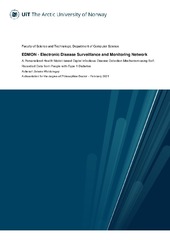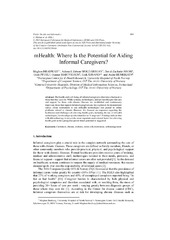Blar i forfatter "Woldaregay, Ashenafi Zebene"
-
Appendix E Telemedisinske løsninger i maritime operasjoner og redningstjeneste
Woldaregay, Ashenafi Zebene; Hartvigsen, Gunnar; Walderhaug, Ståle (Research report; Forskningsrapport, 2016)Folk som jobber i maritime miljø har ikke enkel tilgang til sentrale helsetjenester, og det gjelder spesielt for sjøfolk som arbeider i arktiske områder. Selv om telemedisin har vært en suksess på land, har telemedisin kun i begrenset grad blitt tatt i bruk til havs. Dette skyldes blant annet fravær av gode kommunikasjonsløsninger, dårlige værforhold, store avstander og lange perioder utenfor ... -
Cluster Detection Mechanisms for Syndromic Surveillance Systems: Systematic Review and Framework Development
Yeng, Prosper; Woldaregay, Ashenafi Zebene; Solvoll, Terje Geir; Hartvigsen, Gunnar (Journal article; Tidsskriftartikkel; Peer reviewed, 2020-05-26)Background:The time lag in detecting disease outbreaks remains a threat to global health security. The advancement of technology has made health-related data and other indicator activities easily accessible for syndromic surveillance of various datasets. At the heart of disease surveillance lies the clustering algorithm, which groups data with similar characteristics (spatial, temporal, or both) to ... -
Data-Driven and Artificial Intelligence (AI) Approach for Modelling and Analyzing Healthcare Security Practice: A Systematic Review
Yeng, Prosper; Nweke, Livinus Obiora; Woldaregay, Ashenafi Zebene; Yang, Bian; Snekkenes, Einar Arthur (Journal article; Tidsskriftartikkel; Peer reviewed, 2020-03)Data breaches in healthcare continue to grow exponentially, calling for a rethinking into better approaches of security measures towards mitigating the menace. Traditional approaches including technological measures, have significantly contributed to mitigating data breaches but what is still lacking is the development of the “human firewall,” which is the conscious care security practices of the ... -
Data-driven blood glucose pattern classification and anomalies detection: Machine-learning applications in Type 1 diabetes
Woldaregay, Ashenafi Zebene; Årsand, Eirik; Botsis, Taxiarchis; Albers, David; Mamykina, Lena; Hartvigsen, Gunnar (Journal article; Tidsskriftartikkel; Peer reviewed, 2019-05-01)<p><i>Background - </i>Diabetes mellitus is a chronic metabolic disorder that results in abnormal blood glucose (BG) regulations. The BG level is preferably maintained close to normality through self-management practices, which involves actively tracking BG levels and taking proper actions including adjusting diet and insulin medications. BG anomalies could be defined as any undesirable reading ... -
Data-driven modeling and prediction of blood glucose dynamics: Machine learning applications in type 1 diabetes
Woldaregay, Ashenafi Zebene; Årsand, Eirik; Walderhaug, Ståle; Albers, David; Mamykina, Lena; Botsis, Taxiarchis; Hartvigsen, Gunnar (Journal article; Tidsskriftartikkel; Peer reviewed, 2019-07-26)<i>Background</i>: Diabetes mellitus (DM) is a metabolic disorder that causes abnormal blood glucose (BG) regulation that might result in short and long-term health complications and even death if not properly managed. Currently, there is no cure for diabetes. However, self-management of the disease, especially keeping BG in the recommended range, is central to the treatment. This includes actively ... -
Dataset of fitness trackers and smartwatches to measuring physical activity in research
Henriksen, André; Woldaregay, Ashenafi Zebene; Muzny, Miroslav; Hartvigsen, Gunnar; Hopstock, Laila Arnesdatter; Grimsgaard, Sameline (Journal article; Tidsskriftartikkel; Peer reviewed, 2022-07-16)Objectives: Accelerometer-based wrist-worn ftness trackers and smartwatches (wearables) appeared on the consumer market in 2011. Many wearable devices have been released since. The objective of this data paper is to describe a dataset of 423 wearables released before July 2017.<p> <p>Data description: We identifed wearables and extracted information from six online and ofine databases. We ... -
Dataset of motivational factors for using mobile health applications and systems
Henriksen, André; Issom, David-Zacharie; Woldaregay, Ashenafi Zebene; Pfuhl, Gerit; Årsand, Eirik; Sato, Keiichi; Hartvigsen, Gunnar (Journal article; Tidsskriftartikkel; Peer reviewed, 2023-09-16)We created and carried out a cross-sectional anonymous structured questionnaire on what motivates users of mobile health applications and wearables to share their collected health related data. The questionnaire was distributed online in English, French, and Norwegian. In addition, a flyer with information of where to locate the online questionnaire was distributed during a Swiss health conference. ... -
Design and Prestudy Assessment of a Dashboard for Presenting Self-Collected Health Data of Patients With Diabetes to Clinicians: Iterative Approach and Qualitative Case Study
Giordanengo, Alain; Årsand, Eirik; Woldaregay, Ashenafi Zebene; Bradway, Meghan; Grøttland, Astrid; Hartvigsen, Gunnar; Granja, Conceição; Torsvik, Torbjørn; Hansen, Anne Helen (Journal article; Tidsskriftartikkel; Peer reviewed, 2019-07-09)<p><i>Background - </i>Introducing self-collected health data from patients with diabetes into consultation can be beneficial for both patients and clinicians. Such an initiative can allow patients to be more proactive in their disease management and clinicians to provide more tailored medical services. Optimally, electronic health record systems (EHRs) should be able to receive self-collected health ... -
EDMON - a system architecture for real-time infection monitoring and outbreak detection based on self-recorded data from people with type 1 diabetes: system design and prototype implementation
Coucheron, Sverre; Woldaregay, Ashenafi Zebene; Årsand, Eirik; Botsis, Taxiarchis; Hartvigsen, Gunnar (Journal article; Tidsskriftartikkel; Peer reviewed, 2019-11)Infection incidences in people with diabetes can create sever health complications mainly due to the effect of stress hormones, such as cortisol and adrenaline, which increases glucose production and insulin resistance in the body. The proposed electronic disease surveillance monitoring network (EDMON) relies on self-recorded data from people with Type 1 diabetes and dedicated algorithms to detect ... -
EDMON - Electronic Disease Surveillance and Monitoring Network: A Personalized Health Model-based Digital Infectious Disease Detection Mechanism using Self-Recorded Data from People with Type 1 Diabetes
Woldaregay, Ashenafi Zebene (Doctoral thesis; Doktorgradsavhandling, 2021-05-28)Through time, we as a society have been tested with infectious disease outbreaks of different magnitude, which often pose major public health challenges. To mitigate the challenges, research endeavors have been focused on early detection mechanisms through identifying potential data sources, mode of data collection and transmission, case and outbreak detection methods. Driven by the ubiquitous nature ... -
Electronic disease surveillance system based on inputs from people with diabetes: an early outbreak detection mechanism.
Woldaregay, Ashenafi Zebene (Master thesis; Mastergradsoppgave, 2016-05-18)Objective: Generally, the purpose of this thesis project is to develop an effective electronic disease surveillance system, which is capable of detecting a cluster of people with elevated blood glucose (BG) levels within a specific region and timeframe by analyzing diabetes data. Specifically, we mainly focus on developing an early outbreak detection algorithm that can analyze BG data and detect ... -
Expectations of users and non-users of wearable sensors and mobile health applications
Henriksen, André; Pfuhl, Gerit; Woldaregay, Ashenafi Zebene; Issom, David-Zacharie; Årsand, Eirik; Sato, Keiichi; Hartvigsen, Gunnar (Chapter; Bokkapittel, 2022-08-22)Patient self-management is vital to improved health outcomes for patients with chronic diseases. The objective of this study was to understand the role of wearable sensors in patients’ self-management. A survey encompassing factors related to motivation in mHealth was conducted. Ease of use and sensory accuracy was found most important when choosing a wearable. Manual registration of most health-related ... -
Factors Influencing Motivation and Engagement in Mobile Health Among Patients With Sickle Cell Disease in Low-Prevalence, High-Income Countries: Qualitative Exploration of Patient Requirements
Issom, David-Zacharie; Henriksen, André; Woldaregay, Ashenafi Zebene; Rochat, Jessica; Lovis, Christian; Hartvigsen, Gunnar (Journal article; Tidsskriftartikkel; Peer reviewed, 2020-03-24)<i>Background</i>: Sickle cell disease (SCD) is a hematological genetic disease affecting over 25 million people worldwide. The main clinical manifestations of SCD, hemolytic anemia and vaso-occlusion, lead to chronic pain and organ damages. With recent advances in childhood care, high-income countries have seen SCD drift from a disease of early childhood mortality to a neglected chronic disease of ... -
K-CUSUM: Cluster Detection Mechanism in EDMON
Yeng, Prosper; Woldaregay, Ashenafi Zebene; Hartvigsen, Gunnar (Journal article; Tidsskriftartikkel; Peer reviewed, 2019-11)The main goal of the EDMON (Electronic Disease Monitoring Network) project is to detect the spread of contagious diseases at the earliest possible moment, and potentially before people know that they have been infected. The results shall be visualized on real-time maps as well as presented in digital communication. In this paper, a hybrid of K-nearness Neighbor (KNN) and cumulative sum (CUSUM), known ... -
mHealth: Where Is the Potential for Aiding Informal Caregivers?
Bradway, Meghan; Woldaregay, Ashenafi Zebene; Issom, David-Zacharie; Pfuhl, Gerit; Hartvigsen, Gunnar; Årsand, Eirik; Henriksen, André (Journal article; Tidsskriftartikkel; Peer reviewed, 2021)The health and well-being of informal caregivers often take a backseat to those that they care for. While systems, technologies, and services that provide care and support for those with chronic illnesses are established and continuously improved, those that support informal caregivers are less explored. An international survey about motivations to use mHealth technologies was posted to online ... -
A Novel Approach for Continuous Health Status Monitoring and Automatic Detection of Infection Incidences in People With Type 1 Diabetes Using Machine Learning Algorithms (Part 2): A Personalized Digital Infectious Disease Detection Mechanism
Woldaregay, Ashenafi Zebene; Launonen, Ilkka Kalervo; Albers, David; Igual, Jorge; Årsand, Eirik; Hartvigsen, Gunnar (Journal article; Tidsskriftartikkel; Peer reviewed, 2020-08-12)<i>Background</i>: Semisupervised and unsupervised anomaly detection methods have been widely used in various applications to detect anomalous objects from a given data set. Specifically, these methods are popular in the medical domain because of their suitability for applications where there is a lack of a sufficient data set for the other classes. Infection incidence often brings prolonged ... -
Reinforcement learning application in diabetes blood glucose control: A systematic review
Tejedor Hernandez, Miguel Angel; Woldaregay, Ashenafi Zebene; Godtliebsen, Fred (Journal article; Tidsskriftartikkel; Peer reviewed, 2020-02-21)<p>Background: Reinforcement learning (RL) is a computational approach to understanding and automating goal-directed learning and decision-making. It is designed for problems which include a learning agent interacting with its environment to achieve a goal. For example, blood glucose (BG) control in diabetes mellitus (DM), where the learning agent and its environment are the controller and the body ... -
A systematic review of cluster detection mechanisms in syndromic surveillance: Towards developing a framework of cluster detection mechanisms for EDMON system
Yeng, Prosper Kandabongee; Woldaregay, Ashenafi Zebene; Solvoll, Terje; Hartvigsen, Gunnar (Journal article; Tidsskriftartikkel; Peer reviewed, 2018)Time lag in detecting disease outbreaks remains a threat to global health security. Currently, our research team is working towards a system called EDMON, which uses blood glucose level and other supporting parameters from people with type 1 diabetes, as indicator variables for outbreak detection. Therefore, this paper aims to pinpoint the state of the art cluster detection mechanism towards developing ... -
Telemedicine Services for the Arctic: A systematic review
Woldaregay, Ashenafi Zebene; Walderhaug, Ståle; Hartvigsen, Gunnar (Journal article; Tidsskriftartikkel; Peer reviewed, 2017-06-28)Background: Telemedicine services have been successfully used in areas where there are adequate infrastructures such as reliable power and communication lines. However, despite the increasing number of merchants and seafarers, maritime and Arctic telemedicine have had limited success. This might be linked with various factors such as lack of good infrastructure, lack of trained onboard personnel, ... -
Toward Detecting Infection Incidence in People With Type 1 Diabetes Using Self-Recorded Data (Part 1): A Novel Framework for a Personalized Digital Infectious Disease Detection System
Woldaregay, Ashenafi Zebene; Launonen, Ilkka Kalervo; Årsand, Eirik; Albers, David; Holubova, Anna; Hartvigsen, Gunnar (Journal article; Tidsskriftartikkel; Peer reviewed, 2020-08-12)<i>Background</i>: Type 1 diabetes is a chronic condition of blood glucose metabolic disorder caused by a lack of insulin secretion from pancreas cells. In people with type 1 diabetes, hyperglycemia often occurs upon infection incidences. Despite the fact that patients increasingly gather data about themselves, there are no solid findings that uncover the effect of infection incidences on key ...


 English
English norsk
norsk


















